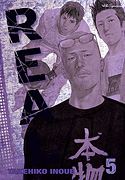 It’s kind of a dead week for manga in terms of new arrivals at comic shops, so what better way to spend it than by focusing on a book that deals with dead bodies? Conveniently enough, the highlight of this week’s arrivals is the 10th volume of The Kurosagi Corpse Delivery Service (Dark Horse), written by Eiji (MPD-Psycho) Otsuka and illustrated by Housui (Mail) Yamazaki. In another bit of fortuitous timing, Johanna (Manga Worth Reading) Draper Carlson has just added this series to her roster of Recommended Series:
It’s kind of a dead week for manga in terms of new arrivals at comic shops, so what better way to spend it than by focusing on a book that deals with dead bodies? Conveniently enough, the highlight of this week’s arrivals is the 10th volume of The Kurosagi Corpse Delivery Service (Dark Horse), written by Eiji (MPD-Psycho) Otsuka and illustrated by Housui (Mail) Yamazaki. In another bit of fortuitous timing, Johanna (Manga Worth Reading) Draper Carlson has just added this series to her roster of Recommended Series:
“The Kurosagi Corpse Delivery Service, it was well-recommended, but I wasn’t sure it was for me, given that it was classified as horror and the premise involved lovingly depicted dead bodies. I’m glad I went ahead and tried it, because I very much enjoyed it. It reminded me of Pushing Daisies, if that show was more laconic and Japanese.”
Kristen Chenoweth could totally play Makino, the embalmer. And musical numbers are just about the only thing that could actually improve this title, though I think musical numbers improve just about everything.
Johanna points to this entry from Shaenon K. Garrity’s Overlooked Manga Festival. Tremble before the force of her persuasive writing:
“Anyway, Kurosagi is a horror comic, in kind of the same way ‘Scream’ was a horror movie, or ‘Buffy’ was a horror TV show. That is, it’s smart and self-aware and full of pop-cult references and weird little factoids. Writer Eiji Otsuka likes to show off just how damn clever he is by mixing two offbeat elements no other manga writer would think of into a single story. A story about crop circles and mummified chimpanzees. Professional mourners and a serial killer who targets depressing blogs. The urban legend about the bride kidnapped from a dressing room and turned into a circus freak and the Japanese version of the ‘Bodyworlds’ corpse-art exhibition. The Rape of Nanking and soap people. And so on.”
What, you need more persuasion? Or maybe you’re worried about not being able to find the volumes in order? Let Kate (The Manga Critic) Dacey put your mind at ease:
“A final tip: you don’t need to read the volumes in order — or even all of them, for that matter — to enjoy The Kurosagi Corpse Delivery Service, though I highly recommend all nine volumes.”
That about covers it, don’t you think?



 Still, if I had my way, Hinako Ashihara’s
Still, if I had my way, Hinako Ashihara’s 

 The first may be the fact that Real is perceived as sports manga, which seems to be right up there with josei in terms of stateside salability. Sports manga partisans are devoted, but they are not numerous. Now, I have a theory as to why this category might be significantly less popular in the United States than it is in Japan. It involves a fair amount of stereotyping, so I apologize in advance if this reasoning doesn’t apply to you, and I acknowledge that there will certainly be exceptions, possibly numerous.
The first may be the fact that Real is perceived as sports manga, which seems to be right up there with josei in terms of stateside salability. Sports manga partisans are devoted, but they are not numerous. Now, I have a theory as to why this category might be significantly less popular in the United States than it is in Japan. It involves a fair amount of stereotyping, so I apologize in advance if this reasoning doesn’t apply to you, and I acknowledge that there will certainly be exceptions, possibly numerous. But Real isn’t actually a sports manga. It’s a character-driven drama. There’s certainly athletic activity being portrayed, and some characters are motivated by their desire to excel in competitive sports, but that’s really just one color in the book’s spectrum of aspirations. It’s much more about achieving independence and respect, which are much more universal.
But Real isn’t actually a sports manga. It’s a character-driven drama. There’s certainly athletic activity being portrayed, and some characters are motivated by their desire to excel in competitive sports, but that’s really just one color in the book’s spectrum of aspirations. It’s much more about achieving independence and respect, which are much more universal. Real suffers from neither of those failings. It’s gritty and funny and, as I noted before, driven by complex characters. There are no plaster saints in Inoue’s cast. That’s not to say that they’re unsympathetic, and I think the fact that they can be obnoxious or alienating makes the audience’s sympathetic reaction more genuine. Their flaws negate the potentially queasy feeling of abstract pity in favor of actual identification.
Real suffers from neither of those failings. It’s gritty and funny and, as I noted before, driven by complex characters. There are no plaster saints in Inoue’s cast. That’s not to say that they’re unsympathetic, and I think the fact that they can be obnoxious or alienating makes the audience’s sympathetic reaction more genuine. Their flaws negate the potentially queasy feeling of abstract pity in favor of actual identification.